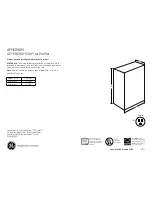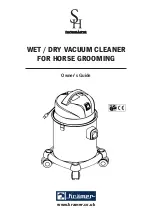
www.scheppach.com /
+(49)-08223-4002-99 /
+(49)-08223-4002-58
19 / 120
•
Remaining hazards can be minimized by following
the instructions in “Safety Precautions”, “Proper
Use“ and in the entire operating manual.
Keep this safety information in a safe place.
6. Technical data
Technical Data
Dimensions L x W x H
(mm):
1075 x 680 x 1800
Overall height with
filter bag mm
1800
Ectractor duct
connections ø mm
140
Hose length mm
2000
Approx. weight kg
44
Rate of air flow m
3
/h
2000
Pressure differential
Pa
1600
Filter aera (filter bag)
m
2
ca. 1,6
Sawdust bag capacity
litres
130
Performance
Electric motor
220-240 V / 50 Hz
Nominal input P1
1,1 kW
Output power P2
0,6 kW
Motorspeed 1/min.
2800
Work Place Emissions Values:
Empty Run Noise dB
(A)
96
Working Noise dB (A)
76
7.
Assembly
For packaging reasons your machine is delivered in
semi-assembled state.
• Using the screws and nuts supplied, screw together
parts A, B and C of the cladding as shown in Figure
2+3.
•
Mount the axle and rollers on the base plate with
the screws and nuts, see Figure 4+5. Then set the
chassis on the wheels.
• Screw the side parts D and E of the cladding toge-
ther in the middle using 3 screws and 3 nuts. (Fi
-
gure 6+7)
•
Fasten the screwed parts A, B, C to the side clad
-
ding (D, E), see Figure 8+9.
•
Set the fully assembled cladding on the base plate
of the chassis and fasten this using 4 screws and 4
nuts. (Figure 10)
• Position the housing with motor on the cladding and
screw it tight using the screws and nuts. (Figure
11+12)
• Slide the clamping strip through the loops on the
filter bag.
• Insert the retainer rod in the housing and hang the
filter bag over it, then fasten the filter bag to the con
-
tainer using the clamping strip (Figure 13+14).
•
Note the information published by your professio
-
nal associations.
•
Do not use any low-powered machines for heavy
duty work.
• Do not mis-use the cable
•
Make sure you stand squarely and keep your ba
-
lance at all times.
• Check that the moving parts are in good working
order, that they do not jam, and that no parts are
damaged. Make sure that all parts are fitted cor
-
rectly and that all other operating conditions are
properly fulfilled.
• Unless otherwise stated in the operating instruc-
tions, damaged safety devices and parts have to
be repaired or replaced by an authorized service
center.
•
Have damaged switches replaced by a customer
service workshop.
•
This electric tool complies with the pertinent safety
regulations. Repairs are to be carried out only by
a qualified electrician using original replacement
parts or the user may suffer an accident.
•
If necessary, wear suitable personal protection
equipment. This could consist of:
- Ear-muffs to prevent the risk of damaging your
hearing
- A breathing mask to prevent the risk of inhaling
hazardous dust
• The operator has to be informed about the condi-
tions with an influence on noise development.
• Faults on the machine have to be reported to the
person in charge as soon as they are discovered.
• This appliance is not suitable for the collection of
dangerous dust.
•
This equipment is not designed to be used by peop
-
le (including children) with limited physical, sensory
or mental capacities or those with no experience
and/or knowledge unless they are supervised by a
person who is responsible for their safety or they
have received instructions from such a person in
how to use the equipment safely. Children must al
-
ways be supervised in order to ensure that they do
not play with the equipment.
Remaining hazards
The machine has been built using modem techno-
logy in accordance with recognized safety rules.
Some remaining hazards, however, may still exist.
• Wood chips and sawdust can be health hazards.
Be sure to wear personal protective gear such as
safety goggles and a dust mask.
•
Dust inhalation may occur when closing and replac
-
ing the dust bag.
• Please note the instructions concerning proper dis-
posal in the operating manual (e.g. the use of P2
dust masks) to prevent dust inhalation.
• Noise can be a health hazard. The permitted noise
level is exceeded when working. Be sure to wear
personal protective gear such as ear protection.
• The use of incorrect or damaged mains cables can
lead to injuries caused by electricity.
•
Even when all safety measures are taken, some re
-
maining hazards which are not yet evident may still
be present.
GB
















































